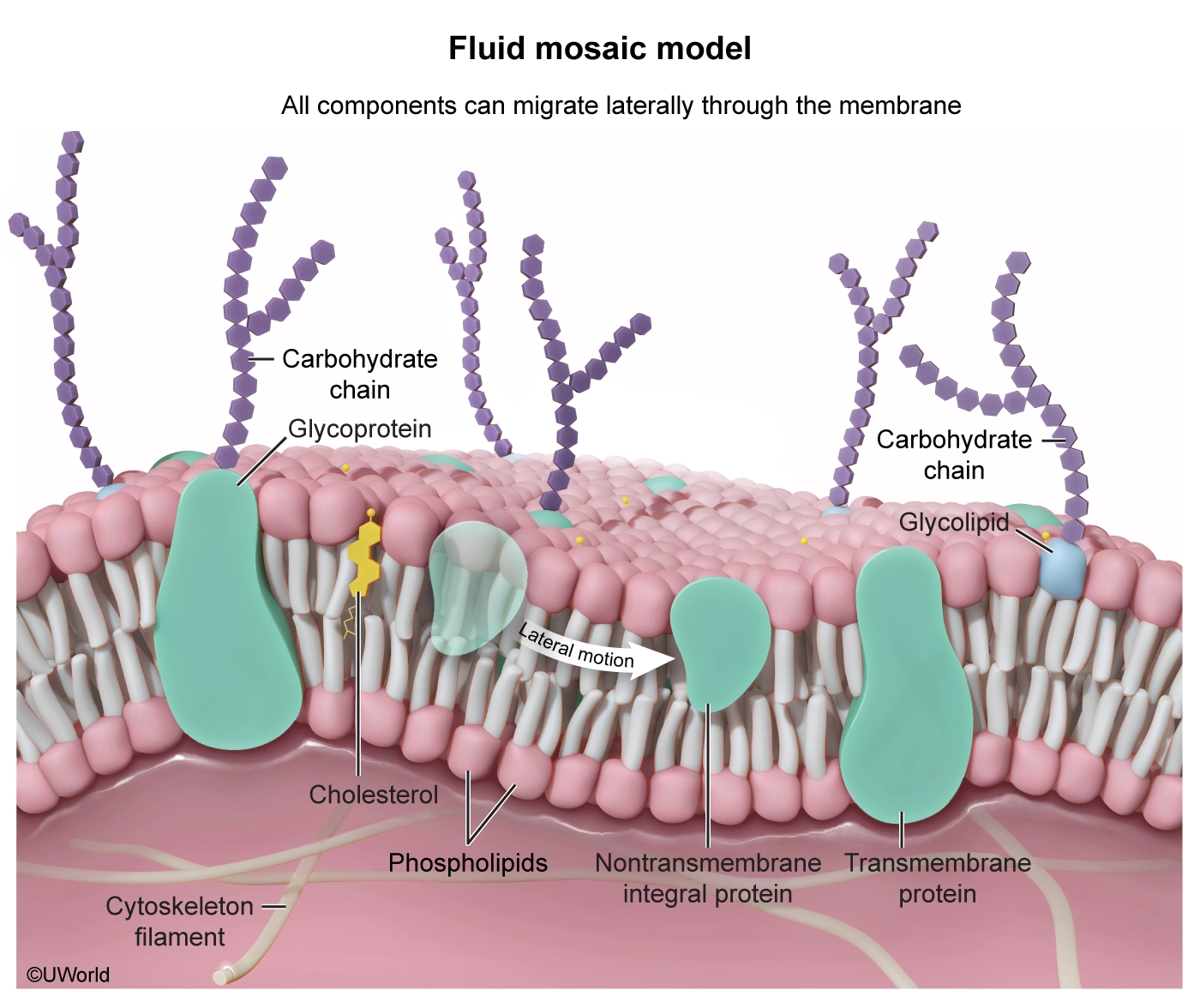MCAT® Biochemistry
Topics, Practice Questions, and Study Strategies
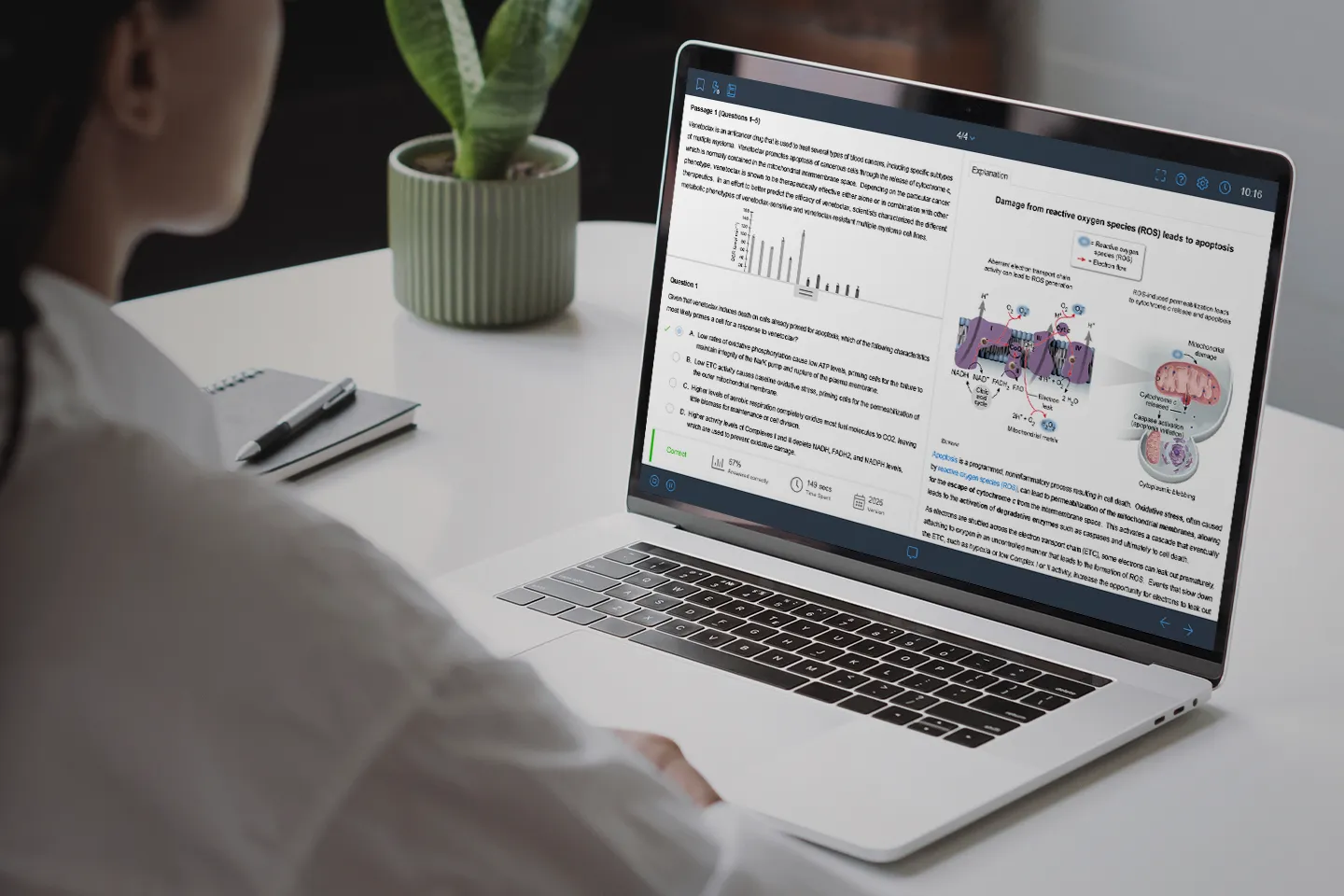
The Biological and Biochemical Foundations of Living Systems MCAT unit assesses your understanding of various concepts related to living organisms' molecular and cellular foundations. Specifically, biochemistry has 30 questions, evenly divided between the MCAT Chem/Phys section (15 questions) and the MCAT Biochem/Bio section (15 questions). Let’s dive into a comprehensive overview of MCAT biochemistry concepts, key study tips, and the ultimate MCAT prep platform to ensure you earn a top biochem score.
MCAT Biochemistry Topics in the Biological and Biochemical Foundations of Living Systems Section
Biochemistry is just one topic within this foundation, comprising 25% of the total bio/biochem sections. Scores range from 118-132. You'll need approximately 1.6 minutes per question. This section tests you on key concepts like anatomy, physiology, and the four major macromolecules: proteins, lipids, carbohydrates, and nucleic acids. Demonstrate your knowledge of scientific reasoning, research methods, and statistics. Let’s look at the biochemistry topics you’ll encounter in the exam's biological and biochemical foundations of living systems section.
|
Biological and Biochemical Foundations of Living Systems Section 59 Questions |
|
|---|---|
| First-semester Biochemistry, 25% | 25% |
| Introductory Biology | 65% |
| General Chemistry | 5% |
| Organic Chemistry | 5% |
Foundational Biochemistry Concepts
Content Category 1A
- Amino Acids
- Protein Structure
- Non-Enzymatic Protein Function
- Enzyme Structure and Function
- Control of Enzyme Activity
Content Category 1B
- Nucleic Acid Structure and Function
Content Category 1D
- Principles of Bioenergetics
- Carbohydrates
- Glycolysis, Gluconeogenesis, and the Pentose Phosphate Pathway
- Principles of Metabolic Regulation
- Citric Acid Cycle
- Metabolism of Fatty Acids and Proteins
- Oxidative Phosphorylation
- Hormonal Regulation and Integration of Metabolism
Content Category 2A
- Plasma Membrane
Content Category 2C
- Biosignaling
Content Category 3A
- Biosignaling
- Lipids
How Is Biochemistry Tested on the MCAT?
Biochemistry may be a complex subject, but we’re here to provide an overview of each core topic to ensure you pass the MCAT with flying colors. There are four different topics assessed during the MCAT biochem section. Here’s how each one breaks down:
- Skill 1 Questions (Knowledge of Scientific Concepts and Principles) comprise 35% of the Biology/Biochemistry section.
- Skill 2 Questions (Scientific Reasoning & Problem-Solving) make up 45% of the Biology/Biochemistry segment.
- Skill 3 Questions (Reasoning about the Design and Execution of Research) constitute 10% of the Biology/Biochemistry portion.
- Skill 4 Questions (Data-based Statistical Reasoning) are 10% of the Biology/Biochemistry section.
Laying the Foundation: Skill 1
This segment assesses your knowledge of fundamental scientific concepts. Most questions will be standalone or may require passage reading to answer them correctly. All in all, skill one questions are straightforward and don’t often require deeper reasoning or concept application beyond the basics. You’ll simply need to:
- Recognize scientific principles from an example, situation, or study.
- Assess the relationships between different representations of concepts.
- Identify examples of observations that illustrate scientific principles.
Exploring Scientific Reasoning: Skill 2
With the help of the right test prep, you’ll feel confident applying your MCAT knowledge to solve complex problems. In this section, illustrate what you know by analyzing scientific theories and the credibility of claims presented within a passage to draw conclusions. You’ll need to memorize specific formulas, like the Michaelis-Menten equation, which describes the rate of enzymatic reactions. Here’s what these concepts will look like:
- Reason about scientific principles, theories, and models to make predictions.
- Analyze and evaluate the validity or credibility of scientific explanations.
- Bring together theory, observations, and evidence to draw conclusions.
Demonstrating Your Design and Research Knowledge: Skill 3
Be successful on the MCAT by showcasing your ability to understand how scientists create and manipulate research experiments. You’ll need to identify components of scientific methodology, including confounding variables, sample sizes, limitations, and ethics. Additionally, you’ll be asked to:
- Identify the role of theory, past findings, hypotheses, and observations in scientific questioning.
- Distinguish between samples and populations and between results that support and fail to support generalizations.
- Use reasoning to evaluate the appropriateness, precision, and accuracy of tools used to conduct research in the natural sciences.
Analyzing Data and Statistics: Skill 4
Finally, you’ll master the biochemistry section of the MCAT by interpreting results using tables, graphs, and charts. Understand statistical equations like solving for P-values, error bars, and R-values for correlation coefficients. You’ll also:
- Use, analyze, and interpret data in figures, graphs, and tables to draw a conclusion about expected results.
- Evaluate measures of central tendency and measures of dispersion to describe data.
- Apply reasoning about statistical significance and uncertainty to conclusions that can or cannot be made.
MCAT Chemical and Physical Foundations of Biological Systems Section
Biochemistry is 25% of the chemical and physical foundations of biological systems section, and the scores range from 118-132. This section tests you on key concepts like anatomy, physiology, and the four major macromolecules: proteins, lipids, carbohydrates, and nucleic acids. Demonstrate your knowledge of scientific reasoning, research methods, and statistics. Let’s look at other topics you’ll encounter on the MCAT Biochemistry portion of the chemical and physical foundations of biological systems section.
|
Chemical and Physical Foundations of Biological Systems Section
59 Questions |
|
|---|---|
| First-semester Biochemistry, 25% | 25% |
| Introductory Biology | 5% |
| General Chemistry | 30% |
| Organic Chemistry | 15% |
| Introductory Physics | 25% |
Review Sample Questions from the MCAT Biochemistry Section
Carefully read the industry-leading questions from our QBank below and submit your answers to explore UWorld’s dynamic prep, expertly designed to help you maximize your potential.
The cells of plants are coated with an outer layer called a cuticle that helps protect against water loss, frost, ultraviolet radiation, and damage from insects. The cuticle primarily consists of a molecule called cutin, which is composed of wax molecules linked together. These wax precursors of cutins are produced and linked together in the cytoplasm to form functional cutin, which is then exported to the extracellular matrix.
Researchers interested in characterizing the proteins involved in transporting cutin to the extracellular matrix created several mutant lines of the plant Arabidopsis thaliana. Lines with defects in the gene designated dso (which encodes the DSO protein) manifested abnormalities in the cuticle. The DSO protein is hypothesized to be localized to lipid rafts in the plasma membrane. To determine how the DSO protein is involved in cuticle formation, cutin was isolated from wild-type and dso-mutant plants and hydrolyzed into its precursor components. The precursors were then analyzed by gas chromatography and mass spectrometry. Levels of several classes of cutin precursors were obtained from the cuticles (Table 1).
Table 1 Levels of Several Cutin Precursor Classes Found in Wild-Type and dso-Mutant Arabidopsis thaliana Cuticles
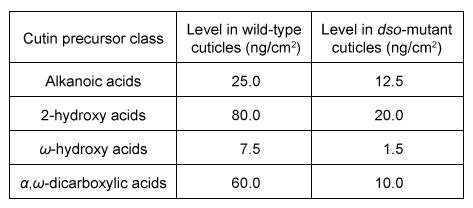
Based on the hypothesized localization of DSO proteins, the region of the plasma membrane that surrounds DSO is most likely rich in which of the following molecules relative to other plasma membrane regions?
| A.Sterols | ||
| B. Phospholipids | ||
| C. Prostaglandins | ||
| D.Triglycerides |
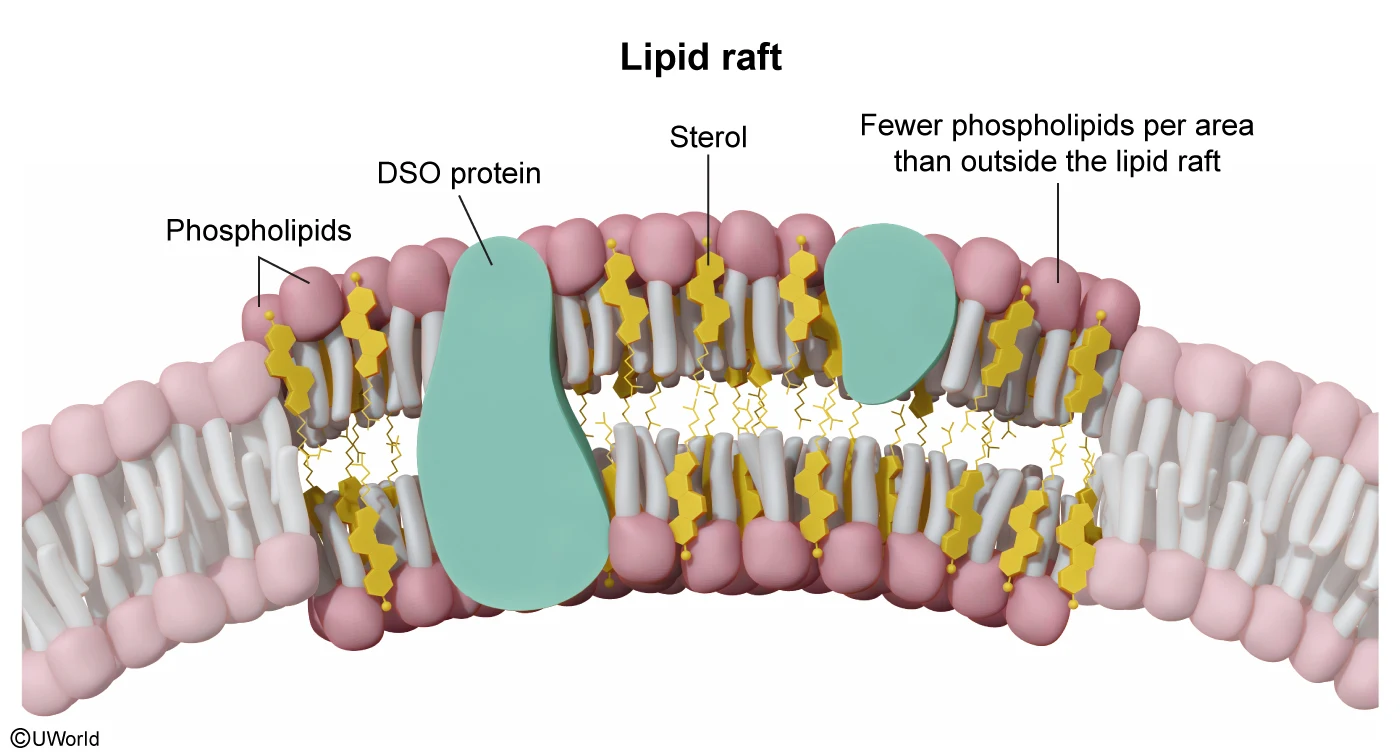
Lipid rafts are regions of relatively high order (ie, low entropy) of the cell membrane. These regions are believed to help localize distinct processes or pathways to specific regions of the membrane by recruiting the proteins and other components involved and holding them in proximity to each other (rather than being allowed to drift freely). To maintain a more ordered state, lipid rafts tend to be rich in sterols (cholesterol in animals and similar molecules called phytosterols in plants) and relatively poor in phospholipids compared to other regions of the membrane.
The passage states that DSO is hypothesized to be localized to lipid rafts. Therefore, DSO is most likely in an environment that is rich in cholesterol compared to other regions of the plasma membrane.
(Choice B) Lipid rafts have a lower percentage of phospholipids than nonraft regions of the membrane, so DSO is expected to be in a region that is relatively poor in phospholipids.
(Choice C) Prostaglandins are nonhydrolyzable lipids that are involved in inflammatory responses. They are not generally found in cell membranes.
(Choice D) Triglycerides are molecules in which three fatty acids are each linked to a glycerol molecule. These molecules are used for energy storage rather than structure, and are not generally found in cell membranes.
Educational objective:
Lipid rafts are relatively ordered domains
within a cell membrane that
help localize the components of certain processes to a defined region. These domains
tend to be rich in
cholesterol and relatively poor in phospholipids.
Which additional observation would support the conclusion that the DSO protein transports cutins to the extracellular matrix?
| A. Wild-type plants synthesize more cutin precursors in a given amount of time than dso-mutant plants. | ||
| B. Wild-type plants degrade extracellular cutin at a lower rate than dso-mutant plants. | ||
| C. dso-mutant plants have high levels of cutin and cutin precursors in the cytosol relative to wild-type plants. | ||
| D. dso-mutant plants assemble cutin precursors into functional cutin less efficiently than wild-type plants. |
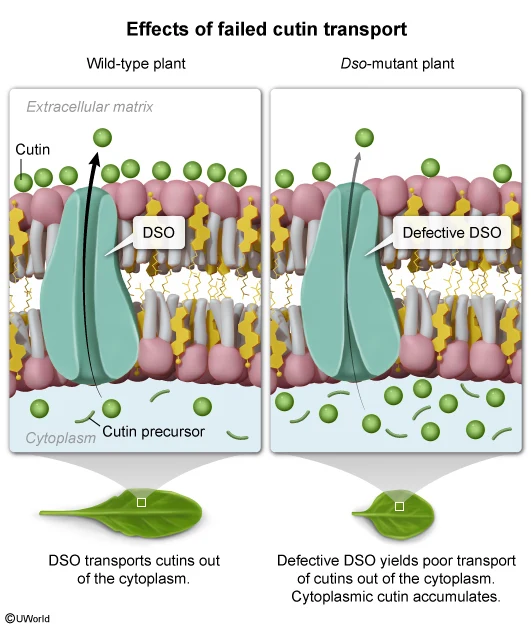
Experimental observations may have more than one explanation. For conclusions to be drawn from such experiments, additional observations must be made to either rule out or support each possible explanation.
The results presented in Table 1 indicate that cutin components are found at lower levels in the cuticles of dso mutant plants than in wild-type plants. The passage also states that cutins are assembled in the cytoplasm prior to transport to the extracellular matrix (ECM), where the cuticle is located. Therefore, one possible explanation for the dso-associated decrease of extracellular cutin is that DSO transports cutin from the cytoplasm to the ECM, and failed transport deprives the cuticle of cutin. However, it is also possible that DSO is involved in the synthesis of cutin precursors or the assembly of precursors into functional cutin, and that dso-mutant plants simply fail to produce cutin in the first place.
If DSO transports cutins, then cutin precursor synthesis and assembly into functional cutin may not be affected in dso-mutant plants. Consequently, if mutant plants exhibit an abnormally high accumulation of cutin and its precursors in the cytoplasm but less cutin in the cuticle as previously observed, this new observation would support the conclusion that DSO transports cutins from the cytoplasm to the ECM.
(Choice A) If wild-type plants synthesized more cutin precursors than dso-mutant plants, this would suggest that functional DSO is involved in precursor synthesis rather than transport.
(Choice B) If wild-type plants degraded extracellular cutin at a lower rate than dso-mutant plants, this would suggest that functional DSO inhibits cutin degradation.
(Choice D) If dso-mutant plants assembled cutin precursors into functional cutin less efficiently than wild-type plants, this would suggest that DSO plays a role in cutin assembly rather than transport.
Educational objective:
Experimental observations may have multiple
explanations. To support specific conclusions, additional experiments may be needed.
Which of the following functional groups is most likely abundant in cutin molecules?
A. 
|
||
B. 
|
||
C. 
|
||
D.
|
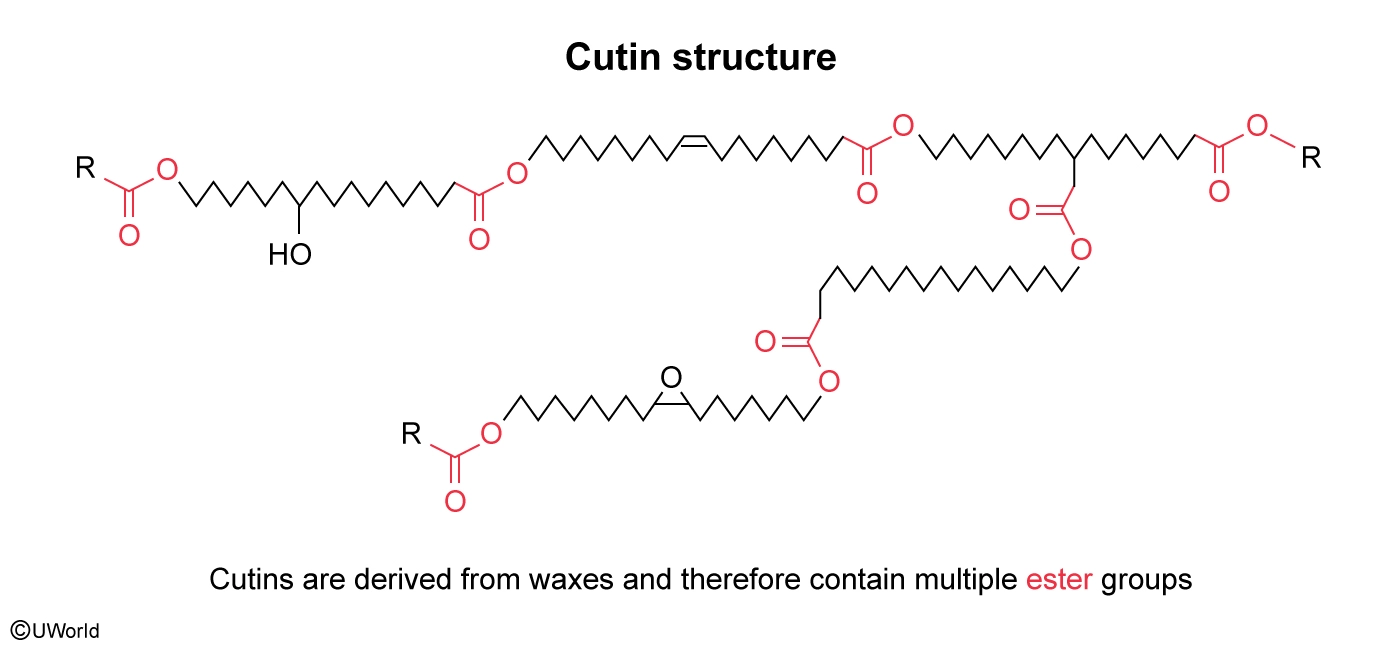
Waxes are lipid molecules that typically form soft solids that are malleable at room temperature. Most waxes are composed of two sets of long-chain hydrocarbons linked together through an ester group, which generally forms when a long-chain alcohol reacts with a long-chain fatty acid.
The passage states that cutins are composed of multiple wax molecules linked together; therefore, cutins most likely contain multiple ester groups. This class of functional group is correctly depicted by the diagram shown in Choice C.
(Choices A, B, and D) These diagrams depict an ether, a ketone, and an acid anhydride, respectively. Although these functional groups may be present in waxes, ester groups are much more common and more likely to be abundant in cutin.
Educational objective:
Most waxes in nature consist of long alkyl
chains linked together through an ester bond.
Dive into 5 MCAT Biochemistry Study Tips and Strategies
Prepping for the MCAT doesn’t have to be intimidating. With the right strategy and an intuitive platform like UWorld, you can earn your medical school spot in no time.
- Identify your goals. Set realistic and achievable goals. Ensure you have enough time to prepare adequately for the MCAT. For example, review content for two months and test your knowledge for four months to solidify concepts.
- Organize study materials. Choose which MCAT materials you’ll be using for review: books, online resources, practice tests, or interactive prep that provides a multi-layered learning experience.
- Simulate testing conditions. Incorporate MCAT practice tests with AAMC-style content and timed conditions, ensuring you’ll feel confident going into the exam.
Retain concepts like enzyme inhibition, Michaelis-Menten kinetics, and Lineweaver-Burk plots with detailed images and diagrams. Find ways to engage in active study to learn dense concepts faster. For example, MCAT test prep that includes links to high-impact images with deeper explanations helps you visualize complex concepts.
Familiarize yourself with primary, secondary, tertiary, and quaternary protein structures and properties of the 20 most common amino acids. It’s easiest to get intricate concepts to stick by implementing flashcards with spaced repetition so you can immediately target areas that need improvement.
Spaced-repetition technology is adaptable and personalized to your study progress, allowing you to review challenging topics more often until you master them. In fact, spaced-repetition technology can improve long-term retention by 200%.
The MCAT biochemistry section contains some of the exam’s most difficult-to-interpret figures and tables. When tackling figures and tables, you should:
- Begin by reading the description to grasp the main idea.
- Identify the X and Y axes to understand the independent and dependent variables.
- Examine the legend to pinpoint which parameters influence the dependent variable.
Then, quiz yourself with concept checks to address knowledge gaps and learn how to analyze figures and tables quickly. Review with comprehensive questions and step-by-step explanations that vividly break down each topic, teaching you how to progress through the exam at your desired pace.
As you approach the final stages of your MCAT preparation, create personalized practice tests tailored to your strengths and weaknesses. Design a test that focuses on areas where you historically struggle and challenge yourself with higher-level questions. This process reinforces your understanding and provides a real-time assessment of your progress, allowing you to fine-tune your study plan well before the exam.
Frequently Asked Questions
What percentage of the MCAT is biochemistry?
Biochemistry is found in the Chemistry/Physics section of the MCAT as well as the Biology/Biochemistry section. Biochemistry comprises 25% of the exam, which amounts to approximately 15 biochemistry questions in each section for a total of 30 biochemistry questions.
How can I improve my MCAT biochemistry score?
You can improve your MCAT biochemistry score by tracking your study progress and addressing knowledge gaps to determine which concepts you still need to learn. Review with comprehensive questions and step-by-step explanations that vividly break down each topic to promote active learning.
How important is the Biochemistry section of the MCAT?
Biochemistry is extremely important when it comes to doing well on the MCAT. It’s the one section of the exam that spans two major areas of the test: Chemistry/Physics section and Biology/Biochemistry. Out of all of the science topics on the MCAT, biochemistry makes up the highest percentage of questions. Mastering biochemistry is essential to achieving a high score on the MCAT.
Can I self-study for the MCAT biochemistry section?
Yes, you can self-study for the MCAT biochemistry section of the exam! Studying in groups or a class can also help you achieve a great MCAT score. The key to successful self-studying is to choose comprehensive MCAT prep with detailed explanations and high-impact images. Ensure you’re actively learning vital concepts in an immersive study environment that reflects AAMC content.





